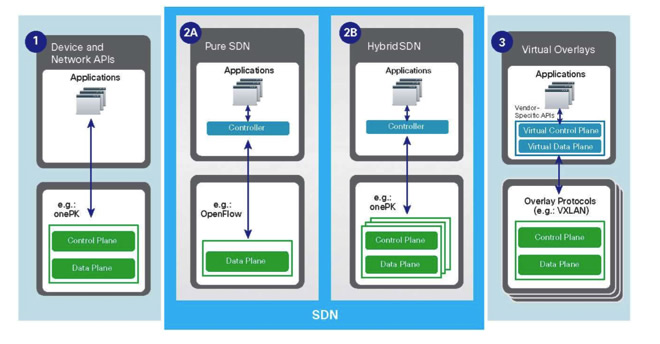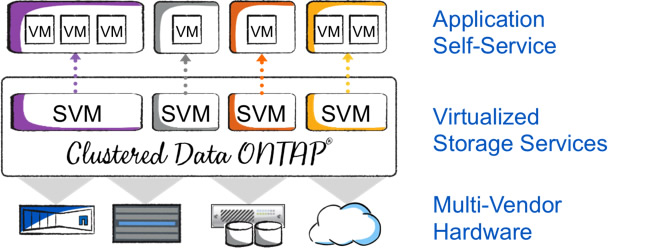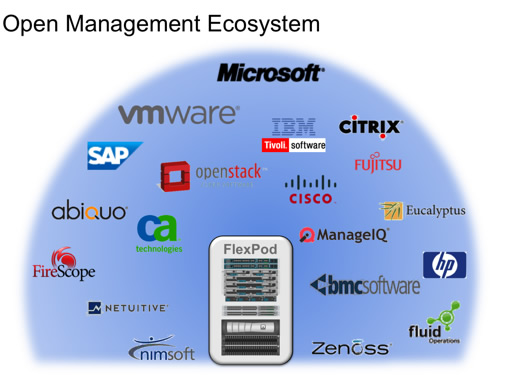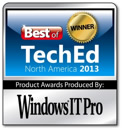


The software-defined data center (SDDC) is an emerging market trend that describes how IT resources can be defined in software, provisioned according to policies, and delivered via API integration. The goal of SDDC is to accelerate the speed of service delivery to users and application owners, drive down costs, and decrease complexity.
To achieve this, data centers have to move beyond basic provisioning tasks and be able to quickly deliver integrated services that span the infrastructure. Compute, networking, and storage have to be defined and managed in software to create a data center that's fully automated, policy enforced, and application driven.
Sound too good to be possible? The reality is that Cisco and NetApp are well on the way to being able to deliver these capabilities, particularly with the FlexPod® converged infrastructure platform.
In this article we look at some of the hardware requirements—compute, network, and storage—as well as the management and orchestration needs of the software-defined data center. We explain what you need to be aware of if you're moving toward a software-defined data center today.
Delivering on the Promise of SDDC

Loosely speaking, a software-defined data center is driven by two critical capabilities:
- Manageability. This requires tight integration with underlying hardware, the ability to customize management through APIs, and the ability to choose to use the tools you prefer.
- Programmability. Applications must be able to provision and access services directly from IT infrastructure as needed.
In an ideal world, you'd be able to apply SDDC capabilities to any and all underlying hardware, but, right now, the key to success with SDDC is choosing underlying devices that provide the necessary level of manageability and programmability.
This means that you have to have a level of consistency across your entire infrastructure. If your management software can't talk to your storage, or your switch lacks open APIs, you could be stuck. The following sections explore the requirements for each infrastructure element in more detail.
Although it's certainly possible to put together infrastructure that delivers on the promise of SDDC, in many cases converged infrastructure solutions, especially FlexPod, may offer the fastest and easiest path to success.
Compute

When you think about compute, it's easy to conclude that server and desktop virtualization are enough to satisfy SDDC compute requirements; in fact it's a common mistake to believe that virtualization is synonymous with SDDC.
Although there's no question that virtualization has been revolutionary, when you dig a little deeper you discover that compute for SDDC requires two additional things:
- Better control over the hardware
- Support for multiple hypervisors
Control at the Hardware Layer
In virtualized environments there are almost always hardware challenges associated with things like the BIOS version, firmware, and the instruction set of the processor. Incompatibilities can introduce limitations or complications. Anyone who's ever attempted to do a vMotion® operation to a server that doesn't have the right BIOS or firmware settings knows that this is true. In some instances a single firmware configuration difference may be enough to prevent vMotion activity between servers.
In addition, many if not most data centers still have a combination of virtualized and bare-metal servers. Ideally, a software-defined data center can manage bare-metal servers with the same dexterity as virtual servers and support all workloads equally well.
The capability to provide service profiles that work at the physical layer and can work in concert with your virtual infrastructure is a key part of Cisco® UCS™. The service profile is able to make sure that the underlying server environment is configured appropriately for whatever is going to run on the server, whether it’s one hypervisor, multiple hypervisors, or a bare-metal OS install.
Multiple Hypervisors. If you aren't doing so already, it's likely that you'll run multiple hypervisors in your data center within the next few years. For example, it is common to run Microsoft® Exchange in a Microsoft virtualized environment. When you use a single vendor for both application and virtualization and it comes time to call for support, you know there won't be any complications. The situation is similar with Oracle® Database and Oracle VM. This multihypervisor model means that both your underlying hardware and your management will need to be increasingly hypervisor agnostic.
Cisco is expanding UCS functionality and UCS Manager software to make UCS even more flexible, more manageable, and more amenable to the software-defined paradigm. All APIs for the environment are exposed, and UCS—whether part of a FlexPod solution or by itself—is hypervisor agnostic and works with any of the hypervisors from VMware, Microsoft, Oracle, Citrix, and Red Hat. UCS management can scale up to allow management of 10,000 or more servers via UCS Central.
Networking

Software-defined networking in the form of VLANs and other network virtualization technologies has been around for more than 20 years. Recent advancements include converged fabric and virtualized switching. The major requirements for networking in the software-defined data center are:
- Multiprotocol support
- Open management and programmability
Multiprotocol Support. This is largely about being able to support the various SAN and NAS protocols that a data center—whether it's software defined or not—may require. This includes Fibre Channel and/or Fibre Channel over Ethernet (FCoE) to support SAN as well as IP networking to support iSCSI and NAS protocols like NFS and CIFS.
As with compute, it really comes down to the capabilities and limitations of the underlying hardware. NetApp and Cisco have pushed hard to achieve industrywide acceptance for FCoE, and we provide support for end-to-end FCoE from storage to host. This means that you need only one cable between servers and storage to support any NAS or SAN protocol that your applications require. You cable once and use software to define the traffic that goes over the wire. As a result, your infrastructure can support any requirement without needing physical changes—an obvious requirement for anything bearing the name "software defined."
Open Management and Programmability. Software-defined networking (SDN) is being widely discussed and debated. The emerging SDN framework can be ideal for some environments, but additional options are needed, especially to support environments that already have substantial investments in network infrastructure.
Cisco developed the Cisco Open Network Environment (ONE) framework as a broad approach to make networks more open, programmable, and application led. ONE incorporates SDN as well as other network deployment models.

Figure 1) The Cisco Open Network Environment (ONE) incorporates SDN and a number of other network deployment models.
The Cisco ONE framework enables you to utilize your existing network infrastructure while being able to add new technologies and services and capitalize on new opportunities. It fully integrates underlying network infrastructure and services with application environments, allowing applications to talk to the infrastructure and the infrastructure to better respond to application requests. This facilitates new business models and allows developers to communicate directly to the network without having to understand all the underlying complexities and subsystems.
You can learn more about Cisco ONE by reading the ONE white paper or this blog post.
Storage

When it comes to the software-defined data center, manageability and programmability are no less important in the storage layer than they are in the compute and network layers.

Figure 2) NetApp® storage addresses SDDC needs with virtualized storage services, support for multivendor hardware, and application self-service.
NetApp has focused on an approach to software-defined storage (SDS) that includes:
- Virtualized storage services. The NetApp clustered Data ONTAP® operating system provides storage services through storage virtual machines (SVMs) that confer capabilities similar to those of virtual machines and server hypervisors. These provide the basis for improved agility, role-based access control and delegation, and the ability to create storage services with predefined data protection, availability, and performance characteristics.
- Multiplatform support. NetApp is focused on the ability to support not just NetApp FAS hardware but third-party storage arrays through NetApp V-Series, commodity hardware, and integration with cloud service providers.
- Application integration and self-service. Integration across the broadest set of infrastructure, management, and application partners provides interoperability; a single, open set of APIs is standardized across all platforms that run Data ONTAP.
FlexPod solutions provide all of these storage capabilities, including the capability to incorporate third-party storage using NetApp V-Series open storage controllers. A more detailed description of the NetApp approach to software-defined storage is provided in a previous Tech OnTap® article.
Management and Orchestration

When it comes to management and orchestration for the software-defined data center, there are three approaches:
- Integrated Converged Infrastructure Managers (CIMs). These manage servers, networks, and storage from a single pane.
- Support for leading management tools. This should include cloud management platforms, tools from vendors such as Microsoft and VMware, and support for major management players such as CA and BMC.
- End-to-end open APIs. These provide the ability to dive in programmatically to make your infrastructure do what you need it to do.
For SDDC, you can make the case that all your infrastructure hardware must support at least two of these approaches: support for leading tools and open APIs. If you have a device that can't be managed by your chosen tools or through APIs, you can find yourself with no path forward.
Most vendors of converged infrastructure lean heavily toward the first option, requiring you to use their management tools and lacking the end-to-end APIs you need for full application integration and programmatic control. This is one of the areas in which Cisco and NetApp have worked to differentiate the FlexPod platform and the components that go into it. FlexPod covers all three of the areas described above.
- For converged infrastructure management, UCS Director, based on Cisco's recent acquisition of Cloupia, is the CIM available with out-of-the-box features for FlexPod. UCS Director also supports other elements within your data center, easing the transition from traditional infrastructure to a converged infrastructure model. In addition, FlexPod comes with element managers for each infrastructure layer, including Cisco UCS Manager and NetApp OnCommand® System Manager.
- Cisco and NetApp have pursued a strategy of open management for FlexPod, which allows us to offer the broadest portfolio of supported management options, including common solutions such as OpenStack, CA, Cisco Intelligent Automation for Cloud, Microsoft System Center, and others.
- APIs are published for every aspect of FlexPod as well as detailed guidelines on what's required for FlexPod management. This means that independent software vendors and your in-house developers can take advantage of every feature the platform provides.

Figure 3) FlexPod provides an open management ecosystem with the broadest support in the industry.
You may have noticed recently that FlexPod has been getting significant recognition, including the Best of TechEd 2013 award for Systems Management and the Microsoft 2013 Server Platform Partner of the Year award. (Check out the sidebar for more details.) We think this says a lot about the usability of the platform.
Application Integration

Although the promise of SDDC is easy integration with any application, it also makes sense to have infrastructure that you know supports specific popular enterprise applications such as Oracle Database, SAP®, and Microsoft Exchange, SQL Server®, and SharePoint®. Specific integrations can facilitate deployment, management, and protection of these and other important applications in a software-defined data center.
NetApp and Cisco are working hard to provide ever-greater support for the software your business relies on. We've been steadily rolling out support for a variety of enterprise software with new Cisco Verified Designs, NetApp Verified Architectures, and solution guides. These tools allow you to deploy enterprise applications on FlexPod more quickly and with better results. You can read about recent enhancements to FlexPod application and infrastructure support as well as other FlexPod enhancements in this Tech OnTap article. The extensive full list of Cisco Validated Designs for FlexPod can be found on the Cisco FlexPod Design Zone website.
With its SnapManager suite of products, NetApp makes data protection and data management easier for important applications and infrastructure, and you can incorporate these operations as part of your SDDC framework. Cisco and NetApp also recently announced FlexPod validation with NetApp SnapProtect™ technology for backup and recovery. SnapProtect's single management console lets you create, catalog, and manage application-aware Snapshot™ copies across disk-to-disk-to-tape processes—making your deployed applications more robust and providing improved service levels to application users.
Conclusion

Architecting a software-defined data center right now is possible, but you have to be careful to choose the right servers, networks, and storage to get good results. Your hardware choices need to offer the right features and work with your chosen management tools and applications. In addition, all your hardware has to offer open APIs. This is important because it not only facilitates integration with management tools, it allows you to integrate your infrastructure with applications.
At the moment, the easiest and fastest way to gain SDDC capabilities is to deploy a converged infrastructure solution, and even then you need to be mindful of manageability and API support. Cisco and NetApp have worked hard to enable our FlexPod platforms to be able to meet SDDC requirements.
All infrastructure elements have the necessary underlying capabilities. Cisco UCS supports service profiles that simplify deployment and movement of application workloads. UCS also supports a wide range of hypervisors, making it effectively hypervisor agnostic. The FlexPod environment supports end-to-end FCoE with available Cisco Nexus® 7000 switches so you can cable once and choose the storage protocols that run over that cable in software. NetApp storage provides exceptional storage virtualization and broad integration with a wide variety of applications and management tools. Finally, all FlexPod components have open APIs to facilitate direct application integration, and we provide certified or validated designs to further accelerate deployment of common enterprise applications.








